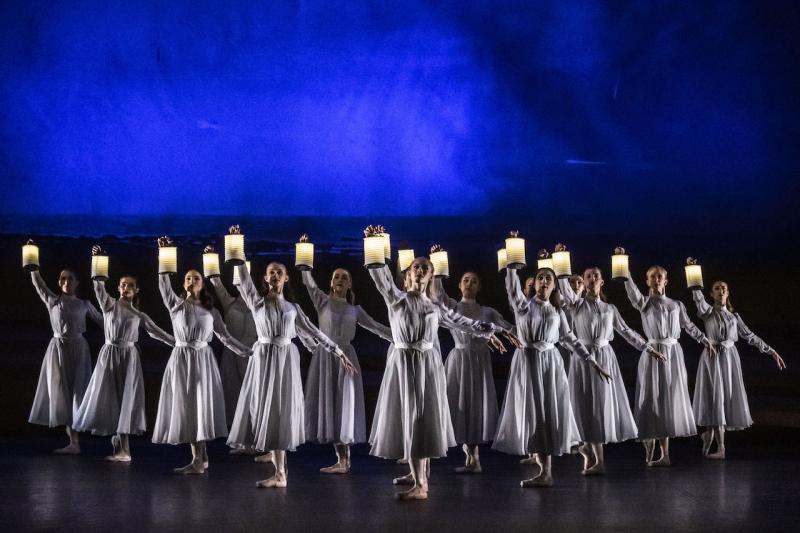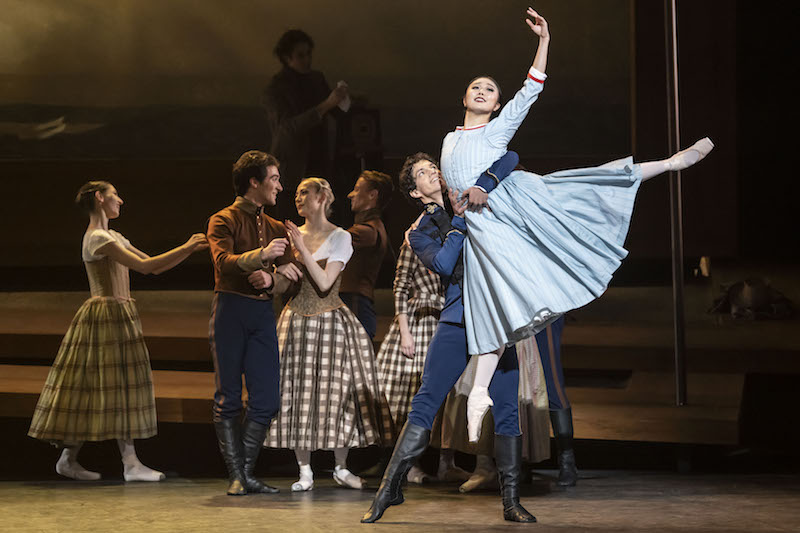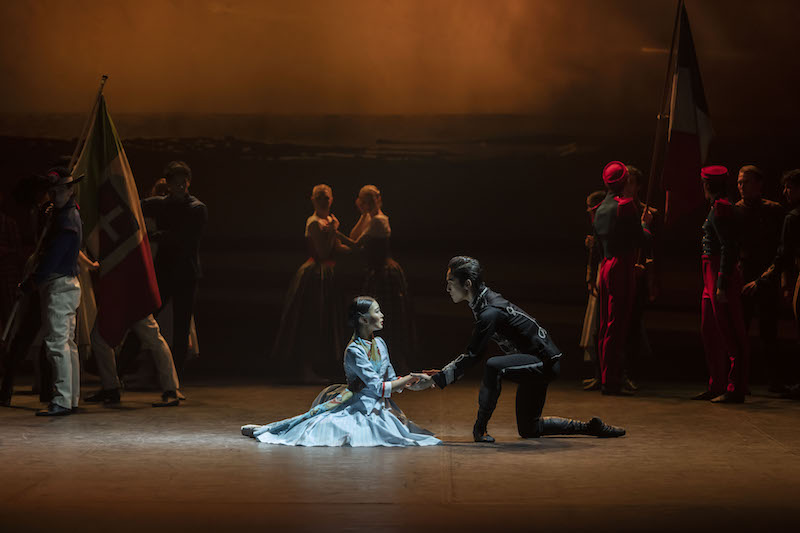Raymonda, English National Ballet, Coliseum review - a creaky old standard, lavishly restored to health | reviews, news & interviews
Raymonda, English National Ballet, Coliseum review - a creaky old standard, lavishly restored to health
Raymonda, English National Ballet, Coliseum review - a creaky old standard, lavishly restored to health
Tamara Rojo gives an ailing veteran a shot in the arm

Neglected classics, whether books, plays or ballets, are usually neglected for a reason, and so it is with the three-act ballet Raymonda. A hit in 1898 for the Imperial ballet in St Petersburg but unperformed in this country since the 1960s, its ineffectual heroine, fuzzy sense of geography and offensively silly plot have made it impossible to stage in full – at least in Britain.
Enter Tamara Rojo, an artistic director hungry for a big new project and willing to put in the academic spadework needed to restore that bowdlerised ballet text. Ditching the original story set at the time of the Crusades, her new staging of Raymonda for English National Ballet moves the action on 600 years to the Crimean war. The titular character is no longer a young woman whose marriage to a knight is decided for her, but a Victorian of good breeding and frustrated ambition who offers her services at the front as a nurse. Her original knightly suitor Jean de Brienne becomes home-counties scion John de Bryan, who takes off with his regiment for Sevastapol. His love-rival undergoes a more subtle change. No longer a bearded infidel bent on abducting our heroine, he is now a suave Ottoman diplomat, an old chum of de Bryan, fiendish only in so far as he is a devil on the ballroom floor, and gallant with it. You soon see where this story is going. There’s a double dilemma: not only which man to choose as a husband, but whether to marry at all, given that nursing vocation.
 OK, so it's hardly a nail-biter for the audience, but at least the heroine has been invested with some agency. In setting the action a few years before Emmeline Pankhurst was so much as a twinkle in her father’s eye, Rojo – making her directoral debut – cannot call on feminist sentiment to supply grit to Raymonda’s character. What she can do and does, by means of astute direction, is make quiet determination look almost heroic, given the strictures on women’s lives in the 1850s. Shiori Kase, the opening night’s Raymonda (pictured above with Isaac Hernandez), makes a strong case for a turbulent inner life while maintaining perfect crinoline decorum.
OK, so it's hardly a nail-biter for the audience, but at least the heroine has been invested with some agency. In setting the action a few years before Emmeline Pankhurst was so much as a twinkle in her father’s eye, Rojo – making her directoral debut – cannot call on feminist sentiment to supply grit to Raymonda’s character. What she can do and does, by means of astute direction, is make quiet determination look almost heroic, given the strictures on women’s lives in the 1850s. Shiori Kase, the opening night’s Raymonda (pictured above with Isaac Hernandez), makes a strong case for a turbulent inner life while maintaining perfect crinoline decorum.
A bigger challenge to this production is the mis-match of Glazunov’s music to the new war-zone setting. Orchestral oom-pah that was composed to accompany Raymonda’s coming-of-age party, which takes up most of the original Act I, now has to serve a gathering outside a Crimean field hospital where Raymonda is tending the wounded. Before a sombre backdrop of the Black Sea swathed in cannon smoke, Raymonda’s flighty friend Henriette (a fearsome Julia Conway) tosses off round after round of giggly virtuoso steps, landing the amorous attention of not one but two dashing officers. Nurses in mufti – taking time out from tending gangrenous limbs – launch into a merry pas de six. Of course this isn’t a documentary, but it stretches credulity even so.
 Elsewhere Rojo softens the disjunct by inserting choreography of her own. Particularly strong is an extended sequence for de Bryan and his regiment showing off their horsemanship (one hand on an imaginary bridle suffices) and general derring-do. Isaac Hernandez, whip smart in his braided uniform, tears up the stage with fabulous virtuosity and the brass section of the ENB Philharmonic have a field day. Rojo also inserts a couple of unusual solos for nursing nun Sister Clemence, whose plot-function is to be to be Raymonda’s conscience. Precious Adams, serene and clear in every step and gesture, makes a star turn from what might otherwise be a glumly saintly cameo.
Elsewhere Rojo softens the disjunct by inserting choreography of her own. Particularly strong is an extended sequence for de Bryan and his regiment showing off their horsemanship (one hand on an imaginary bridle suffices) and general derring-do. Isaac Hernandez, whip smart in his braided uniform, tears up the stage with fabulous virtuosity and the brass section of the ENB Philharmonic have a field day. Rojo also inserts a couple of unusual solos for nursing nun Sister Clemence, whose plot-function is to be to be Raymonda’s conscience. Precious Adams, serene and clear in every step and gesture, makes a star turn from what might otherwise be a glumly saintly cameo.
The most extended challenge for Rojo as a debutante choreographer is a dream sequence, a full-blown fantasia swirling from the mind of Raymonda as she sleeps in her tent. Costumed in white, this makes an ambitious nod to the White Acts of late 19th-century ballet as teams of nurses leap through lines of fallen soldiers, or mass together holding their lamps aloft (pictured top). There are hints of the Kingdom of the Shades scene from Bayadère in a single motif repeated or reflected multiple times. There is also an element of Kenneth MacMillan’s Gloria in the dream-interaction between young soldiers and the girls they long to hold in a better life. If Rojo is to choreograph more – and on the evidence of this she must – her lived experience of so many great ballets will prove a rich storehouse for her imagination. That’s not to say she hasn’t things to learn, but the ease with which she shifts the dance-action between her own choreographic invention and Petipa’s original numbers – such as the famous scarf dance – is already impressive.
Of course, the majority of the audience for Raymonda won’t give a fig for who did the steps for which bit of the ballet. What matters is the dancing and the music, and this production sends you home with your head bursting with the exuberance of both. While my vote for hottest-to-trot would have to go to Jeffrey Cirio’s slinky, heat-seeking torpedo of a suitor, the entire company ups its game. The Hungarian czardas at Raymonda’s wedding almost blows the roof off the Coli, with conductor Gavin Sutherland whipping up a storm from his players, a handful of whom appear on stage with Hungarian folk instruments. Antony McDonald’s costumes and sets provide exactly what's wanted: smart tailoring, some dazzle, a spot of cultural information. A projection of newspaper front pages heralds the ballet, showing fuzzy monochrome photographs of Crimea. Surely there were no war photographers in 1854? It turns out there was one, the very first, an Englishman called Roger Fenton. And he has a walk-on role in this production.
rating
Explore topics
Share this article
The future of Arts Journalism
You can stop theartsdesk.com closing!
We urgently need financing to survive. Our fundraising drive has thus far raised £49,000 but we need to reach £100,000 or we will be forced to close. Please contribute here: https://gofund.me/c3f6033d
And if you can forward this information to anyone who might assist, we’d be grateful.

Subscribe to theartsdesk.com
Thank you for continuing to read our work on theartsdesk.com. For unlimited access to every article in its entirety, including our archive of more than 15,000 pieces, we're asking for £5 per month or £40 per year. We feel it's a very good deal, and hope you do too.
To take a subscription now simply click here.
And if you're looking for that extra gift for a friend or family member, why not treat them to a theartsdesk.com gift subscription?
more Dance
 'We are bowled over!' Thank you for your messages of love and support
Much-appreciated words of commendation from readers and the cultural community
'We are bowled over!' Thank you for your messages of love and support
Much-appreciated words of commendation from readers and the cultural community
 Peaky Blinders: The Redemption of Thomas Shelby, Rambert, Sadler's Wells review - exciting dancing, if you can see it
Six TV series reduced to 100 minutes' dance time doesn't quite compute
Peaky Blinders: The Redemption of Thomas Shelby, Rambert, Sadler's Wells review - exciting dancing, if you can see it
Six TV series reduced to 100 minutes' dance time doesn't quite compute
 Giselle, National Ballet of Japan review - return of a classic, refreshed and impeccably danced
First visit by Miyako Yoshida's company leaves you wanting more
Giselle, National Ballet of Japan review - return of a classic, refreshed and impeccably danced
First visit by Miyako Yoshida's company leaves you wanting more
 Quadrophenia, Sadler's Wells review - missed opportunity to give new stage life to a Who classic
The brilliant cast need a tighter score and a stronger narrative
Quadrophenia, Sadler's Wells review - missed opportunity to give new stage life to a Who classic
The brilliant cast need a tighter score and a stronger narrative
 The Midnight Bell, Sadler's Wells review - a first reprise for one of Matthew Bourne's most compelling shows to date
The after-hours lives of the sad and lonely are drawn with compassion, originality and skill
The Midnight Bell, Sadler's Wells review - a first reprise for one of Matthew Bourne's most compelling shows to date
The after-hours lives of the sad and lonely are drawn with compassion, originality and skill
 Ballet to Broadway: Wheeldon Works, Royal Ballet review - the impressive range and reach of Christopher Wheeldon's craft
The title says it: as dancemaker, as creative magnet, the man clearly works his socks off
Ballet to Broadway: Wheeldon Works, Royal Ballet review - the impressive range and reach of Christopher Wheeldon's craft
The title says it: as dancemaker, as creative magnet, the man clearly works his socks off
 The Forsythe Programme, English National Ballet review - brains, beauty and bravura
Once again the veteran choreographer and maverick William Forsythe raises ENB's game
The Forsythe Programme, English National Ballet review - brains, beauty and bravura
Once again the veteran choreographer and maverick William Forsythe raises ENB's game
 Sad Book, Hackney Empire review - What we feel, what we show, and the many ways we deal with sadness
A book about navigating grief feeds into unusual and compelling dance theatre
Sad Book, Hackney Empire review - What we feel, what we show, and the many ways we deal with sadness
A book about navigating grief feeds into unusual and compelling dance theatre
 Balanchine: Three Signature Works, Royal Ballet review - exuberant, joyful, exhilarating
A triumphant triple bill
Balanchine: Three Signature Works, Royal Ballet review - exuberant, joyful, exhilarating
A triumphant triple bill
 Romeo and Juliet, Royal Ballet review - Shakespeare without the words, with music to die for
Kenneth MacMillan's first and best-loved masterpiece turns 60
Romeo and Juliet, Royal Ballet review - Shakespeare without the words, with music to die for
Kenneth MacMillan's first and best-loved masterpiece turns 60
 Help to give theartsdesk a future!
Support our GoFundMe appeal
Help to give theartsdesk a future!
Support our GoFundMe appeal

Add comment